微观经济学 第七章(曼昆)
- 格式:ppt
- 大小:773.50 KB
- 文档页数:48
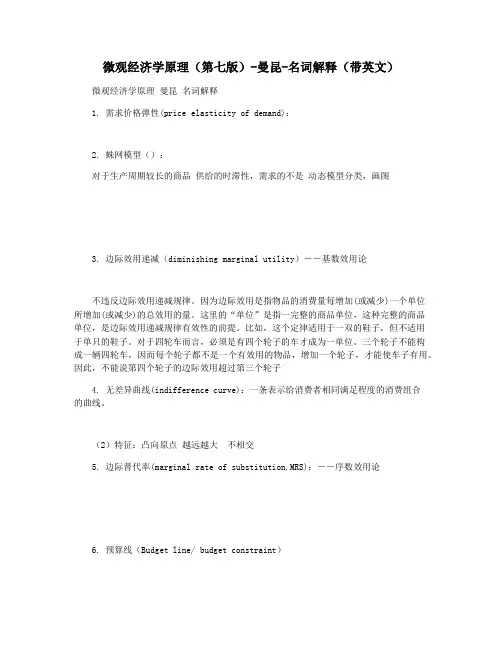
微观经济学原理(第七版)-曼昆-名词解释(带英文)微观经济学原理曼昆名词解释1. 需求价格弹性(price elasticity of demand):2. 蛛网模型():对于生产周期较长的商品供给的时滞性,需求的不是动态模型分类,画图3. 边际效用递减(diminishing marginal utility)――基数效用论不违反边际效用递减规律。
因为边际效用是指物品的消费量每增加(或减少)一个单位所增加(或减少)的总效用的量。
这里的“单位”是指一完整的商品单位,这种完整的商品单位,是边际效用递减规律有效性的前提。
比如,这个定律适用于一双的鞋子,但不适用于单只的鞋子。
对于四轮车而言,必须是有四个轮子的车才成为一单位。
三个轮子不能构成一辆四轮车,因而每个轮子都不是一个有效用的物品,增加一个轮子,才能使车子有用。
因此,不能说第四个轮子的边际效用超过第三个轮子4. 无差异曲线(indifference curve):一条表示给消费者相同满足程度的消费组合的曲线。
(2)特征:凸向原点越远越大不相交5. 边际替代率(marginal rate of substitution.MRS):――序数效用论6. 预算线(Budget line/ budget constraint)7. 吉芬物品(Giffen good):价格上升引起需求量增加的物品。
8. 柯布道格拉斯生产函数稀缺性(scarcity):社会资源的有限性。
经济学(economics):研究社会如何管理自己的稀缺资源。
效率(efficiency):社会能从其稀缺资源中得到最多东西的特性。
平等(equality):经济成果在社会成员中公平分配的特性。
机会成本(opportunity cost):为了得到某种东西所必须放弃的东西。
理性人(rational people):系统而有目的地尽最大努力实现起目标的人。
边际变动(marginal change):对行动计划微小的增量调整。
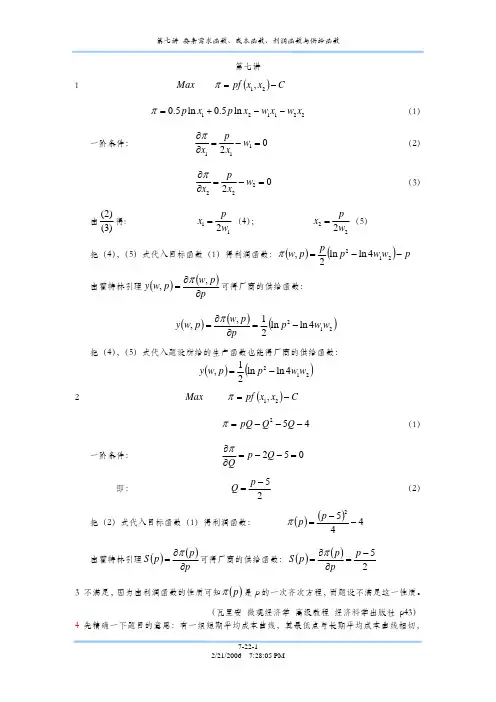
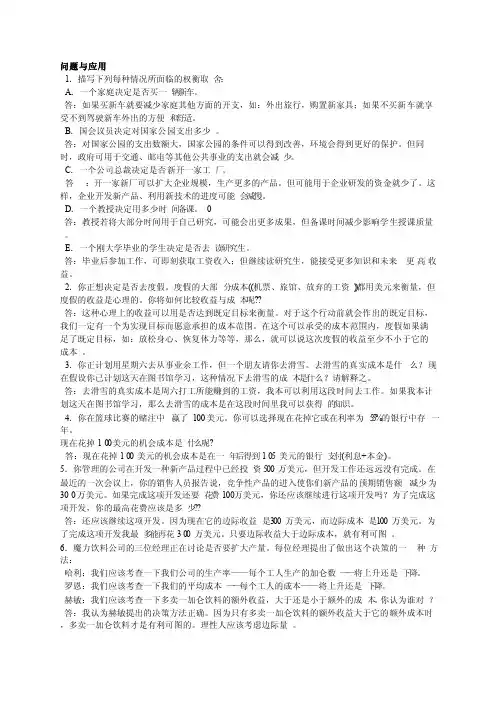
问题与应用1.描写下列每种情况所面临的权衡取舍:A.一个家庭决定是否买一辆新车。
答:如果买新车就要减少家庭其他方面的开支,如:外出旅行,购置新家具;如果不买新车就享受不到驾驶新车外出的方便和舒适。
B.国会议员决定对国家公园支出多少。
答:对国家公园的支出数额大,国家公园的条件可以得到改善,环境会得到更好的保护。
但同时,政府可用于交通、邮电等其他公共事业的支出就会减少。
C.一个公司总裁决定是否新开一家工厂。
答:开一家新厂可以扩大企业规模,生产更多的产品。
但可能用于企业研发的资金就少了。
这样,企业开发新产品、利用新技术的进度可能会减慢。
D.一个教授决定用多少时间备课。
0答:教授若将大部分时间用于自己研究,可能会出更多成果,但备课时间减少影响学生授课质量。
E.一个刚大学毕业的学生决定是否去读研究生。
答:毕业后参加工作,可即刻获取工资收入;但继续读研究生,能接受更多知识和未来更高收益。
2.你正想决定是否去度假。
度假的大部分成本((机票、旅馆、放弃的工资))都用美元来衡量,但度假的收益是心理的。
你将如何比较收益与成本呢??答:这种心理上的收益可以用是否达到既定目标来衡量。
对于这个行动前就会作出的既定目标,我们一定有一个为实现目标而愿意承担的成本范围。
在这个可以承受的成本范围内,度假如果满足了既定目标,如:放松身心、恢复体力等等,那么,就可以说这次度假的收益至少不小于它的成本。
3.你正计划用星期六去从事业余工作,但一个朋友请你去滑雪。
去滑雪的真实成本是什么?现在假设你已计划这天在图书馆学习,这种情况下去滑雪的成本是什么?请解释之。
答:去滑雪的真实成本是周六打工所能赚到的工资,我本可以利用这段时间去工作。
如果我本计划这天在图书馆学习,那么去滑雪的成本是在这段时间里我可以获得的知识。
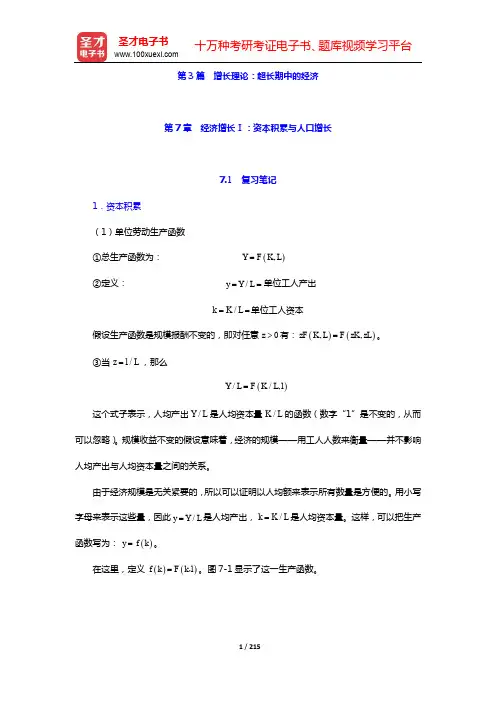
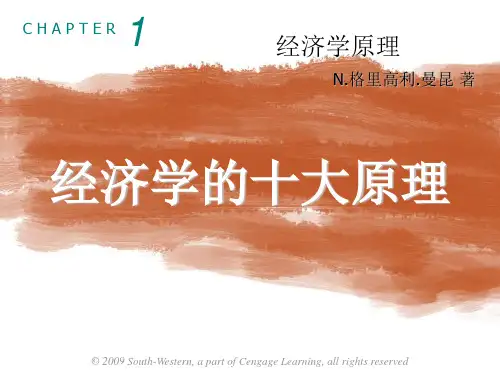
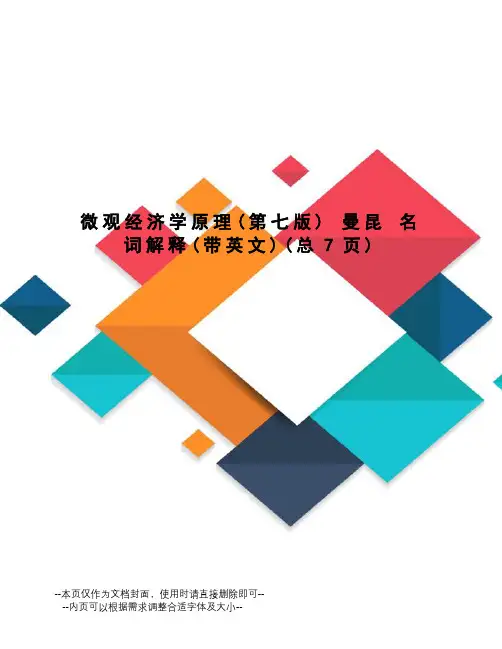
微观经济学原理(第七版)曼昆名词解释(带英文)(总7页)--本页仅作为文档封面,使用时请直接删除即可----内页可以根据需求调整合适字体及大小--微观经济学原理曼昆名词解释稀缺性(scarcity):社会资源的有限性。
经济学(economics):研究社会如何管理自己的稀缺资源。
效率(efficiency):社会能从其稀缺资源中得到最多东西的特性。
平等(equality):经济成果在社会成员中公平分配的特性。
机会成本(opportunity cost):为了得到某种东西所必须放弃的东西。
理性人(rational people):系统而有目的地尽最大努力实现起目标的人。
边际变动(marginal change):对行动计划微小的增量调整。
激励(incentive):引起一个人做出某种行为的某种东西。
市场经济(market economy):当许多企业和家庭在物品与劳务市场上相互交易时,通过他们的分散决策配置资源的经济。
产权(property rights):个人拥有并控制稀缺资源的能力。
市场失灵(market failure):市场本身不能有效配置资源的情况。
外部性(externality):一个人的行为对旁观者福利的影响。
市场势力(market power):一个经济活动者(或经济活动者的一个小集团)对市场价格有显著影响的能力。
生产率(productivity):一个工人一小时所生产的物品与劳务量。
通货膨胀(inflation):经济中物价总水平的上升。
经济周期(business cycle):就业和生产等经济活动的波动(就是生产这类经济活动的波动。
)循环流向图(circular-flow diagram):一个说明货币如何通过市场在家庭与企业之间流动的直观经济模型。
生产可能性边界(production possibilities frontier):表示一个经济在可得到的生产要素与生产技术既定时所能生产的产量的各种组合的图形。
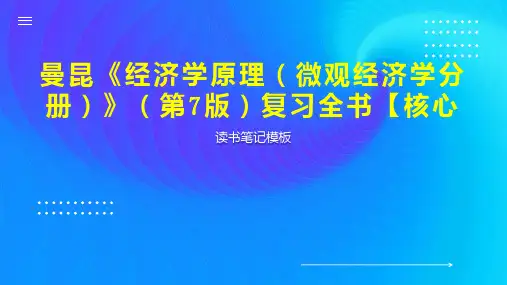
![曼昆_微观经济学_原理_第五版_课后习题答案[1]](https://uimg.taocdn.com/4e613212e87101f69e31953f.webp)
问题与应用1.描写下列每种情况所面临的权衡取舍:A.一个家庭决定是否买一辆新车。
答:如果买新车就要减少家庭其他方面的开支,如:外出旅行,购置新家具;如果不买新车就享受不到驾驶新车外出的方便和舒适。
B.国会议员决定对国家公园支出多少。
答:对国家公园的支出数额大,国家公园的条件可以得到改善,环境会得到更好的保护。
但同时,政府可用于交通、邮电等其他公共事业的支出就会减少。
C.一个公司总裁决定是否新开一家工厂。
答:开一家新厂可以扩大企业规模,生产更多的产品。
但可能用于企业研发的资金就少了。
这样,企业开发新产品、利用新技术的进度可能会减慢。
D.一个教授决定用多少时间备课。
答:教授若将大部分时间用于自己研究,可能会出更多成果,但备课时间减少影响学生授课质量。
E.一个刚大学毕业的学生决定是否去读研究生。
答:毕业后参加工作,可即刻获取工资收入;但继续读研究生,能接受更多知识和未来更高收益。
2.你正想决定是否去度假。
度假的大部分成本((机票、旅馆、放弃的工资))都用美元来衡量,但度假的收益是心理的。
你将如何比较收益与成本呢??答:这种心理上的收益可以用是否达到既定目标来衡量。
对于这个行动前就会作出的既定目标,我们一定有一个为实现目标而愿意承担的成本范围。
在这个可以承受的成本范围内,度假如果满足了既定目标,如:放松身心、恢复体力等等,那么,就可以说这次度假的收益至少不小于它的成本。
3.你正计划用星期六去从事业余工作,但一个朋友请你去滑雪。
去滑雪的真实成本是什么?现在假设你已计划这天在图书馆学习,这种情况下去滑雪的成本是什么?请解释之。
答:去滑雪的真实成本是周六打工所能赚到的工资,我本可以利用这段时间去工作。
如果我本计划这天在图书馆学习,那么去滑雪的成本是在这段时间里我可以获得的知识。
4.你在篮球比赛的赌注中赢了100美元。
你可以选择现在花掉它或在利率为55%的银行中存一年。
现在花掉100美元的机会成本是什么呢?答:现在花掉100 美元的机会成本是在一年后得到105 美元的银行支付(利息+本金)。

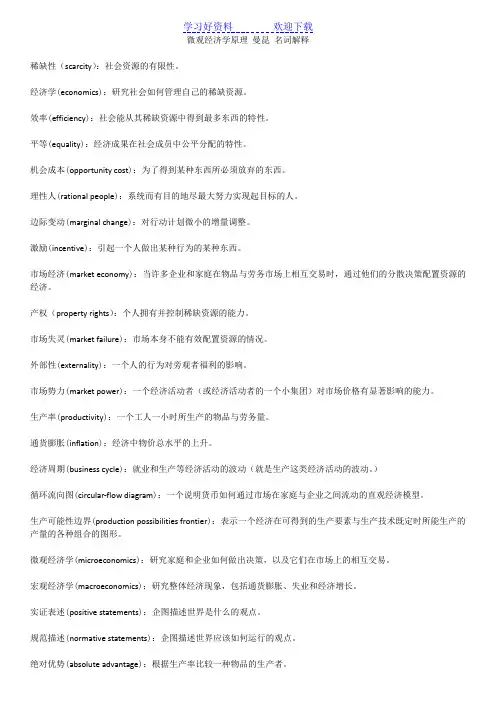
微观经济学原理曼昆名词解释稀缺性(scarcity):社会资源的有限性。
经济学(economics):研究社会如何管理自己的稀缺资源。
效率(efficiency):社会能从其稀缺资源中得到最多东西的特性。
平等(equality):经济成果在社会成员中公平分配的特性。
机会成本(opportunity cost):为了得到某种东西所必须放弃的东西。
理性人(rational people):系统而有目的地尽最大努力实现起目标的人。
边际变动(marginal change):对行动计划微小的增量调整。
激励(incentive):引起一个人做出某种行为的某种东西。
市场经济(market economy):当许多企业和家庭在物品与劳务市场上相互交易时,通过他们的分散决策配置资源的经济。
产权(property rights):个人拥有并控制稀缺资源的能力。
市场失灵(market failure):市场本身不能有效配置资源的情况。
外部性(externality):一个人的行为对旁观者福利的影响。
市场势力(market power):一个经济活动者(或经济活动者的一个小集团)对市场价格有显著影响的能力。
生产率(productivity):一个工人一小时所生产的物品与劳务量。
通货膨胀(inflation):经济中物价总水平的上升。
经济周期(business cycle):就业和生产等经济活动的波动(就是生产这类经济活动的波动。
)循环流向图(circular-flow diagram):一个说明货币如何通过市场在家庭与企业之间流动的直观经济模型。
生产可能性边界(production possibilities frontier):表示一个经济在可得到的生产要素与生产技术既定时所能生产的产量的各种组合的图形。
微观经济学(microeconomics):研究家庭和企业如何做出决策,以及它们在市场上的相互交易。
宏观经济学(macroeconomics):研究整体经济现象,包括通货膨胀、失业和经济增长。
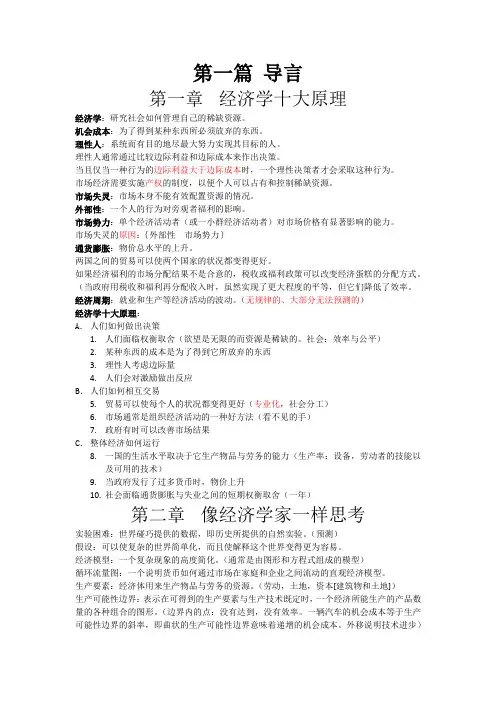
第二章需求与供给四、分析应用题1、根据影响需求的因素的原理,试从中找出影响我国内需不足的主要因素并加以简单说明。
答案要点(1).简述影响需求的因素的原理(7个因素)(2).影响我国内需不足的主要因素,可以从以下一个或几个方面分析:收入水平;人们对未来的预期;消费政策等。
2、请用供给曲线和需求曲线的相关理论说明北京移民对当地居民工资的影响(结合图形分析)。
答案要点:(1)供大于求,导致工资水平下降(2)供等于求,工资水平不变(3)供小于求,工资水平上升需要分别做三组图,每图都需要标出原均衡点和新的均衡点。
3、从经济学的观点来看,你认为以下哪几种是最能促进小轿车进入大多数家庭的方法,为什么?答案要点:(1)提高大多数人的工资能增加消费者的收入,能增加需求;(2)降低小汽车的车价,能增加需求;(3)降低汽车油税,是降低互补品的价格,能增加需求;(4)降低出租车费,是降低替代品的价格,能减少需求;(5)降低停车费,是降低互补品的价格,能增加需求。
4、试作图分析“谷贱伤农”的经济学含义是什么?如何解决“伤农”问题?答案要点,谷物作为农产品,是生活必需品也是需求弹性比较小的商品。
农民丰收引起供给曲线向右下方移动,新的均衡点与旧的均衡点相比,均衡价格下降了但均衡数量上升了,只是作为需求弹性较小的商品,价格下降的幅度大于均衡数量上升的幅度,所以会导致农民的收入降低。
解决措施:支持价格。
供给过剩的谷物由政府通过建立缓冲库存的形式收购。
(图形略)5、政府通常对某些商品征收消费税。
试问,政府能否同时达到这样两个目标:既获得稳定的收入,又抑制了这些商品的生产?征收消费税,会提高商品价格,从而减少商品的需求量。
此时,需求缺乏弹性的商品需求量下降幅度小,需求富有弹性的商品下降幅度大。
因此,只有对需求缺乏弹性的商品征税,政府才能获得稳定的收入。
要抑制某种商品的生产,必须使其总收益下降。
只有需求富于弹性的商品,价格提高了总收益才会下降。
曼昆《经济学原理(微观经济学分册)》(第8版)笔记和课后习题(含考研真题)详解目录第1篇导言第1章经济学十大原理1.1 复习笔记1.2 课后习题详解1.3 名校考研真题详解第2章像经济学家一样思考2.1 复习笔记2.2 课后习题详解2.3 名校考研真题详解第3章相互依存性与贸易的好处3.1 复习笔记3.2 课后习题详解3.3 名校考研真题详解第2篇市场如何运行第4章供给与需求的市场力量4.1 复习笔记4.2 课后习题详解4.3 名校考研真题详解第5章弹性及其应用5.1 复习笔记5.2 课后习题详解5.3 名校考研真题详解第6章供给、需求与政府政策6.1 复习笔记6.2 课后习题详解6.3 名校考研真题详解第3篇市场和福利第7章消费者、生产者与市场效率7.1 复习笔记7.2 课后习题详解7.3 名校考研真题详解第8章应用:税收的代价8.1 复习笔记8.2 课后习题详解8.3 名校考研真题详解第9章应用:国际贸易9.1 复习笔记9.2 课后习题详解9.3 名校考研真题详解第4篇公共部门经济学第10章外部性10.1 复习笔记10.2 课后习题详解10.3 名校考研真题详解第11章公共物品和公共资源11.1 复习笔记11.2 课后习题详解11.3 名校考研真题详解第12章税制的设计12.1 复习笔记12.2 课后习题详解12.3 名校考研真题详解第5篇企业行为与产业组织第13章生产成本13.1 复习笔记13.2 课后习题详解13.3 名校考研真题详解第14章竞争市场上的企业14.1 复习笔记14.2 课后习题详解14.3 名校考研真题详解第15章垄断15.1 复习笔记15.2 课后习题详解15.3 名校考研真题详解第16章垄断竞争16.1 复习笔记16.2 课后习题详解16.3 名校考研真题详解第17章寡头17.1 复习笔记17.2 课后习题详解17.3 名校考研真题详解第6篇劳动市场经济学第18章生产要素市场18.1 复习笔记18.2 课后习题详解18.3 名校考研真题详解第19章收入与歧视19.1 复习笔记19.2 课后习题详解19.3 名校考研真题详解第20章收入不平等与贫困20.1 复习笔记20.2 课后习题详解20.3 名校考研真题详解第7篇深入研究的论题第21章消费者选择理论21.1 复习笔记21.2 课后习题详解21.3 名校考研真题详解第22章微观经济学前沿22.1 复习笔记22.2 课后习题详解22.3 名校考研真题详解内容简介本书遵循曼昆《经济学原理(微观经济学分册)》(第8版)教材的章目编排,共分7篇22章,每章由三部分组成:第一部分为复习笔记,总结本章的重难点内容;第二部分是课(章)后习题详解,对第8版的所有习题都进行了详解的分析和解答;第三部分为名校考研真题详解,精选近年考研真题,并提供了详细的解答。
微观经济学原理曼昆名词解释稀缺性(scarcity):社会资源的有限性。
经济学(economics):研究社会如何管理自己的稀缺资源。
效率(efficiency):社会能从其稀缺资源中得到最多东西的特性。
平等(equality):经济成果在社会成员中公平分配的特性。
机会成本(opportunity cost):为了得到某种东西所必须放弃的东西。
理性人(rational people):系统而有目的地尽最大努力实现起目标的人。
边际变动(marginal change):对行动计划微小的增量调整。
激励(incentive):引起一个人做出某种行为的某种东西.市场经济(market economy):当许多企业和家庭在物品与劳务市场上相互交易时,通过他们的分散决策配置资源的经济。
产权(property rights):个人拥有并控制稀缺资源的能力。
市场失灵(market failure):市场本身不能有效配置资源的情况。
外部性(externality):一个人的行为对旁观者福利的影响。
市场势力(market power):一个经济活动者(或经济活动者的一个小集团)对市场价格有显著影响的能力.生产率(productivity):一个工人一小时所生产的物品与劳务量。
通货膨胀(inflation):经济中物价总水平的上升。
经济周期(business cycle):就业和生产等经济活动的波动(就是生产这类经济活动的波动.)循环流向图(circular—flow diagram):一个说明货币如何通过市场在家庭与企业之间流动的直观经济模型.生产可能性边界(production possibilities frontier):表示一个经济在可得到的生产要素与生产技术既定时所能生产的产量的各种组合的图形.微观经济学(microeconomics):研究家庭和企业如何做出决策,以及它们在市场上的相互交易。
宏观经济学(macroeconomics):研究整体经济现象,包括通货膨胀、失业和经济增长。
微观经济学曼昆第七版答案【篇一:曼昆微观经济学英文版本答案】a family deciding whether to buy a new car faces a tradeoff between the cost of the car and other things they might wantto buy. for example, buying the car might mean they must give up going on vacation for the next two years. so the real cost of the car is the familys opportunity cost in terms of what they must give up.b. for a member of congress deciding whether to increase spending on national parks, the tradeoff is between parks and other spending items or tax cuts. if more money goes into the park system, that may mean less spending on national defense or on the police force. or, instead of spending more money on the park system, taxes could be reduced.c. when a company president decides whether to open a new factory, the decision is based on whether the new factory will increase the firms profits compared to other alternatives. for example, the company could upgrade existing equipment or expand existing factories. the bottom line is: which method of expanding production will increase profit the most?d. in deciding how much to prepare for class, a professor faces a tradeoff between the value of improving the quality of the lecture compared to other things she could do with her time, such as working on additional research.2. when the benefits of something are psychological, such as going on a vacation, it isnt easy to compare benefits to costs to determine if its worth doing. but there are two ways to think about the benefits. one is to compare the vacation with what you would do in its place. if you didnt go on vacation, would you buy something like a new set of golf clubs? then you can decide if youd rather have the new clubs or the vacation. a second way is to think about how much work you had to do to earn the money to pay for the vacation; then you can decide if the psychological benefits of the vacation were worth the psychological cost of working.3. if you are thinking of going skiing instead of working at your part-time job, the cost of skiing includes its monetary and time costs, which includes the opportunity cost of the wagesyou are giving up by not working. if the choice is between skiing and going to the library to study, then the cost of skiing is its monetary and time costs including the cost to you of getting a lower grade in your course.4. if you spend $100 now instead of saving it for a year and earning 5 percent interest, you are giving up the opportunity to spend $105 a year from now. the idea that money has a time value is the basis for the field of finance, the subfield of economics that has to do with prices of financial instruments like stocks and bonds.5. the fact that youve already sunk $5 million isnt relevant to your decision anymore, since that money is gone. what matters now is the chance to earn profits at the margin. if you spend another $1 million and can generate sales of $3 million, youll earn $2 million in marginal profit, so you should do so. you are right to think that the project has lost a total of $3 million ($6 million in costs and only $3 million in revenue) and you shouldnt have started it. thats true, but if you dont spend the additional $1 million, you wont have any sales and your losses will be $5 million. so what matters is not the total profit, but the profit you can earn at the margin. in fact, youd pay up to $3 million to complete development; any more than that, and you wont be increasing profit at the margin.6. harry suggests looking at whether productivity would riseor fall. productivity is certainly important, since the more productive workers are, the lower the cost per gallon of potion. ron wants to look at average cost. but both harry and ron are missing the other side of the equation?revenue. a firm wants to maximize its profits, so it needs to examine both costs and revenues. thus, hermione is right?it’s best to examine whether the extra revenue would exceed the extra costs. hermione is the only one who is thinking at the margin.7. a. the provision of social security benefits lowers an individual’s incentive t o save for retirement. the benefits provide some level of income to the individual when he or she retires. this means that the individual is not entirely dependent on savings to support consumption through the years in retirement.b. since a person gets fewer after-tax social security benefits the greater is his or her earnings, there is an incentive not towork (or not work as much) after age 65. the more you work, the lower your after-tax social security benefits will be. thus the taxation of social security benefits discourages work effort after age 65.18. a. when welfare recipients who are able to work have their benefits cut off after two years, they have greater incentive to find jobs than if their benefits were to last forever.b. the loss of benefits means that someone who cant find ajob will get no income at all, so the distribution of income will become less equal. but the economy will be more efficient, since welfare recipients have a greater incentive to find jobs. thus the change in the law is one that increases efficiency but reduces equity.9. by specializing in each task, you and your roommate can finish the chores more quickly. if you divided each task equally, it would take you more time to cook than it would take your roommate, and it would take him more time to clean than it would take you. by specializing, you reduce the total time spent on chores.10. a. being a central planner is tough! to produce the right number of cds by the right artists and deliver them to the right people requires an enormous amount of information. youneed to know about production techniques and costs in the cd industry. you need to know each persons musical tastes and which artists they want to hear. if you make the wrong decisions, youll be producing too many cds by artists that people dont want to hear, and not enough by others.b. your decisions about how many cds to produce carry overto other decisions. you have to make the right number of cd players for people to use. if you make too many cds and not enough cassette tapes, people with cassette players will be stuck with cds they cant play. the probability of making mistakes is very high. you will also be faced with tough choices about the musicindustry compared to other parts of the economy. if you produce more sports equipment, youll have fewer resourcesfor making cds. so all decisions about the economy influence your decisions about cd production.11. a. efficiency: the market failure comes from the monopoly by the cable tv firm.b. equityc. efficiency: an externality arises because secondhand smoke harms nonsmokers.d. efficiency: the market failure occurs because of standard oils monopoly power.e. equityf. efficiency: there is an externality because of accidents caused by drunk drivers.12. a. if everyone were guaranteed the best health care possible, much more of our nations output would be devoted to medical care than is now the case. would that be efficient? if you think that currently doctors form a monopoly and restrict health care to keep their incomes high, you might think efficiency would increase by providing more health care. but more likely, if the government mandated increased spending on health care, the economy would be less efficient because it would give people more health care than they would choose to pay for. from the point of view of equity, if poor people are less likely to have adequate health care, providing more health care would represent an improvement. each person would have a more even slice of the economic pie, though the pie would consist of more health care and less of other goods.b. when workers are laid off, equity considerations argue for the unemployment benefits system to provide them with some income until they can find new jobs. after all, no one plans to be laid off, so unemployment benefits are a form of insurance. but there’s an efficiency problem?why work if you can get income for doing nothing? the economy isn’t operating efficiently if people remain unemployed for a long time, and unemployment benefits encourage unemployment. thus, there’s a tradeoff between equity and efficiency. the more generous are unemployment benefits, the less income is lost by an unemployed person, but the more that person is encouraged to remain unemployed. so greater equity reduces efficiency.13. since average income in the united states has roughly doubled every 35 years, we are likely to have a better standard of living than our parents, and a much better standard of living than our grandparents. this is mainly the result of increased productivity, so that an hour of work produces more goodsand services than it used to. thus incomes have continuously risen over time, as hasthe standard of living.14. if americans save more and it leads to more spending on factories, there will be an increase in production and productivity, since the same number of workers will have more equipment to work with. the benefits from higher productivity will go to both the workers, who will get paid more since theyre producing more, and the factory owners, who will get a return on their investments. there is no such thing as a free lunch, however, because when people save more, they are giving up spending. they get higher incomes at the cost of buying fewer goods.15. a. if people have more money, they are probably going to spend more on goods and services.b. if prices are sticky, and people spend more on goods and services, then output may increase, as producers increase output to meet the higher demand rather than raising prices.c. if prices can adjust, then the higher spending of consumers will be matched with increased prices and output wont rise.16. to make an intelligent decision about whether to reduce inflation, a policymaker would need to know what causes inflation and unemployment, as well as what determines the tradeoff between them. any attempt to reduce inflation will likely lead to higher unemployment in the short run. a policymaker thus faces a tradeoff between the benefits of lower inflation compared to the cost of higher unemployment. ch21. economics is like a science because economists use the scientific method. they devise theories, collect data, and then analyze these data in an attempt to verify or refute their theories about how the world works. economists use theory and observation like other scientists, but they are limited in their ability to run controlled experiments. instead, they must rely on natural experiments.2. economists make assumptions to simplify problems without substantially affecting the answer. assumptions can make the world easier to understand.3. an economic model cannot describe reality exactly because it would be too complicated to understand. a modelis a simplification that allows the economist to see what is truly important.4. figure 3 shows a production possibilities frontier between milk and cookies (ppf1). if a disease kills half of the economys cow population, less milk production is possible, so the ppf shifts inward (ppf2). note that if the economy produces all cookies, so it doesnt need any cows, then production is unaffected. but if the economy produces any milk at all, then there will be less production possible after the disease hits. figure 35. the idea of efficiency is that an outcome is efficient if the economy is getting all it can from the scarce resources it has available.in terms of the production possibilities frontier, an efficient point is a point on the frontier, such as point a in figure 4. a point inside the frontier, such as point b, is inefficient since more of one good could be produced without reducing the production of another good.6. the two subfields in economics are microeconomics and macroeconomics. microeconomics is the study of how households and firms make decisions and how they interact in specific markets. macroeconomics is the study of economy-wide phenomena.7. positive statements are descriptive and make a claim about how the world is, while normative statements are prescriptive and make a claim about how the world ought to be. here is an example. positive: a rapid growth rate of money is the cause of inflation. normative: the government should keep the growth rate of money low.8. the council of economic advisers is a group of economists who consult with the president of the united states about economic matters. the council consists of three members and a staff of several dozen economists. it writes the annual economic report of the president.9. economists sometimes offer conflicting advice to policymakers for two reasons: (1) economists may disagree about the validity of alternative positive theories about how the world works; and (2) economists may have different values and, therefore, different normative views about what public policy should try to accomplish.ch31. in the text example of the farmer and the rancher, the farmers opportunity cost of producing one ounce of meat is 4 ounces of potatoes because for every 8 hours of work, he can produce 8 ounces of meat or 32 ounces of potatoes. with limited time at his disposal, producing an ounce of meat means he gives up the opportunity to produce 4 ounces of potatoes. similarly, the ranchers opportunity cost of producing one ounce of meat is 2 ounces of potatoes because for every 8 hours of work, she can produce 24 ounces of meat or 48 ounces of potatoes. with limited time at her disposal, producing an ounce of meat means she gives up the opportunity to produce 2 ounces of potatoes.2. a. see figure 2. if maria spends all five hours studying economics, she can read 100 pages, so that is the vertical intercept of the production possibilities frontier. if she spends all five hours studying sociology, she can read 250 pages, so figure 4that is the horizontal intercept. the time costs are constant, so the production possibilities frontier is a straight line.figure 2b. it takes maria two hours to read 100 pages of sociology. in that time, she could read 40 pages of economics. so the opportunity cost of 100 pages of sociology is 40 pages of economics.3. a.b. see figure 3. with 100 million workers and four cars per worker, if either economy were devoted completely to cars, it could make 400 million cars. since a u.s. worker can produce 10 tons of grain, if the united states produced only grain it would produce 1,000 million tons. since a japanese worker can produce 5 tons of grain, if japan produced only grain it would produce 500 million tons. these are the intercepts of the production possibilities frontiers shown in the figure. note that since the tradeoff between cars and grain is constant, the production possibilities frontier is a straight line.【篇二:微观经济学原理(第七版) 曼昆名词解释(带英文)】=txt>稀缺性(scarcity):社会资源的有限性。
第七章:不完全竞争的市场一、名词解释完全垄断、自然垄断、价格歧视、一级价格歧视、二级价格歧视、三级价格歧视、垄断竞争、寡头垄断、古诺模型、斯塔克伯格模型、斯威齐模型。
二、单项选择题1、下列不能成为进入一个行业的壁垒的是()。
A.垄断利润B.立法C.专利权D.资源控制2、下列那一个不是垄断竞争的特征()。
A、厂商数目很少B、进入该行业容易C、存在产品差别D、厂商忽略竞争对手的反应3、一个市场上只有一个厂商,生产一种没有替代品的产品,这样的市场结构被称为()。
A、垄断竞争B、完全垄断C、寡头垄断D、完全竞争4、垄断厂商面临的需求曲线是()。
A、向下倾斜的B、向上倾斜的C、垂直的D、水平的5、垄断厂商拥有控制市场的权力,这意味着()。
A.垄断厂商面对一条向下倾斜的需求曲线B.如果他的产品增加一个单位,则全部产品的销售价格必须降低C.垄断厂商的边际收益曲线低于其需求曲线D.以上都对6、垄断条件下,当商品的需求的价格弹性小于1时,厂商的边际收益()。
A.大于0;B.大于1;C.小于0;D.小于1。
7、垄断利润属于( )。
A.经济成本;B.正常利润;C.经济利润;D.隐成本。
8、当一个行业由竞争演变成垄断行业时,则()。
A.垄断市场的价格等于竞争市场的价格;B.垄断市场的价格大于竞争市场的价格;C.垄断市场的价格小于竞争市场的价格;D.垄断价格具有任意性。
9、在垄断厂商的长短期均衡产量上可以有()。
A.P>LAC;B.P<LAC;C.P等于最小的LAC;D.P等于最小的LMC。
10、一个垄断厂商在长期中一直获得经济利润,那么()。
A.该厂商的生产比竞争性市场的厂商更有效率B.其他厂商无法进入该行业与其竞争C.政府和垄断厂商之间必定串谋来维持一个高价格D.垄断厂商的需求曲线缺乏弹性,从而使得其获得更多的收益11、完全垄断厂商达于长期均衡的条件是:()。
A、MR=MCB、MR=SMC=LMCC、MR=SMC=LMC=SACD、MR=SMC=SAC=LAC12、要有效地实行差别定价,下列那一条以外都是必需具备的条件:()。